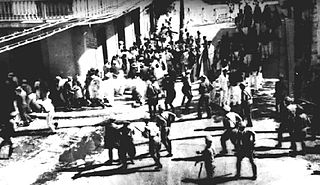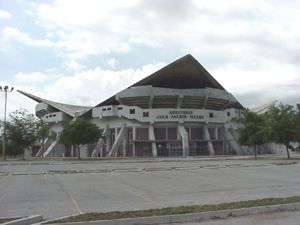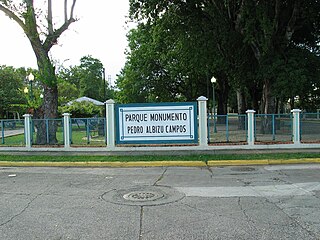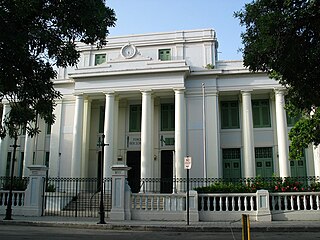
Pedro Albizu Campos was a Puerto Rican attorney and politician, and the leading figure in the Puerto Rican independence movement. Gifted in languages, he spoke six. He graduated from Harvard Law School with the highest grade point average in his law class, an achievement that earned him the right to give the valedictorian speech at his graduation ceremony. However, animus towards his mixed racial heritage led to his professors delaying two of his final exams in order to keep Albizu Campos from graduating on time. During his time at Harvard University he became involved in the Irish struggle for independence.

The following is an alphabetical list of articles related to the Commonwealth of Puerto Rico.

The Ponce massacre was an event that took place on Palm Sunday, March 21, 1937, in Ponce, Puerto Rico, when a peaceful civilian march turned into a police shooting in which 19 civilians and two policemen were killed, and more than 200 civilians wounded. None of the civilians were armed and most of the dead were reportedly shot in their backs. The march had been organized by the Puerto Rican Nationalist Party to commemorate the abolition of slavery in Puerto Rico by the governing Spanish National Assembly in 1873, and to protest the U.S. government's imprisonment of the Party's leader, Pedro Albizu Campos, on sedition charges.

Juan Morel Campos, sometimes erroneously spelled Juan Morell Campos, was a Puerto Rican composer, considered by many to be responsible for taking the genre of danza to its highest level. He composed over 550 musical works before he died unexpectedly at age 38.

The Auditorio Juan Pachín Vicéns, formerly, Coliseo Juan Pachín Vicéns, a.k.a., Coliseo de Ponce, is a sports venue in the city of Ponce, Puerto Rico. The auditorium opened on 12 May 1972, under the mayoral administration of Juan H. Cintrón García and is named after basketball player Juan "Pachín" Vicéns (1934–2007). It was initially known as "Coliseo de Ponce" from its inauguration in 1972 until the 1990s it was baptized under the name Auditorio Juan Pachín Vicéns, to honor the MVP basketball player.

The Parque Pedro Albizu Campos is a passive recreational park in the city of Ponce, Puerto Rico. It was dedicated on 12 September 1991, to the memory of Puerto Rican Nationalist leader Pedro Albizu Campos by the Government of the Autonomous Municipality of Ponce. Dr. Pedro Albizu Campos was born in Ponce on 12 September 1891. He was raised in Ponce and lived most of his life there as well.

The Antiguo Casino de Ponce, or simply the Casino de Ponce, is a historic structure, built in 1922 and located in Barrio Cuarto, Ponce, Puerto Rico. Originally built as a social club for Ponce's elite, it is currently used as the premier reception center of "The Noble City of Puerto Rico". The building, designed by Agustin Camilo Gonzalez in the Second Empire and Neo-Rococo styles, has a French facade and tones. It was listed in the National Register of Historic Places on 28 October 1987. It is located at the corner of Marina and Luna streets. The building has been called "an icon of Ponce's architecture, history, and identity." It is owned and administered by the Ponce Municipal Government. In 1936, during the Great Depression, the Casino declared bankruptcy and shut down. It subsequently had various uses: a postal office, a public health unit, tax collector's office, and even a temporary city hall. In 1990 it was restored by the Ponce Municipal Government, and has since been used for high-ranking official municipal business. For example, it was here where the dinner to honor Prince of Asturias, His Majesty Felipe de Borbon, took place.

The Museo de la Masacre de Ponce is a human rights museum and historic building in Ponce, Puerto Rico. It depicts the history and events surrounding the Ponce massacre, which occurred in broad daylight on Palm Sunday in 1937. The museum is housed inside the building where the event itself occurred, with one of its sections devoted to the Nationalist leader, Pedro Albizu Campos. It also documents the blacklisting of Puerto Rican Nationalists performed by the United States, as well as hosting a considerable number of photos from the Nationalist era.

The Panteón Nacional Román Baldorioty de Castro is a tract of land in Barrio Segundo of the city of Ponce, Puerto Rico, originally designed as the city's cemetery, but later converted into what has come to be a famous burial place. Established in 1842, it is Puerto Rico's first national pantheon. It is the only cemetery dedicated as a museum in Puerto Rico and the Caribbean. Prior to being dedicated as a Panteón Nacional, it was known as Cementerio Viejo or as Cementerio Antiguo de Ponce, and is listed under that name on the U.S. National Register of Historic Places. The Pantheon is named after Román Baldorioty de Castro, a prolific Puerto Rican politician, and firm believer of Puerto Rican autonomy and independence. His remains are located here. The Pantheon also houses a small museum about the history of autonomism in the Island, and it is currently used both as a park and a venue for the expression of culture and the arts. It is called the Museo del Autonomismo Puertorriqueño.

The Ponce High School is public educational institution in Ponce, Puerto Rico, offering grades nine through twelve. The school's main building is a historic structure located on Cristina Street, in the Ponce Historic Zone. From its beginning the school has secured a unique place in Puerto Rico's educational history. Of over 3,000 schools erected in Puerto Rico in the first quarter of the twentieth century, Ponce High was the largest, "at a time enrolling more students than all the other Puerto Rico high schools combined", and for many years enrolling more students than any other high school in Puerto Rico. The cost of the building in 1915 dollars was $150,000 USD. The building was listed on the U.S. National Register of Historic Places on 4 August 1987. The school has the only diamond-level DECA chapter in Puerto Rico. The Ponce High School building is "among the most important public buildings ever built in Puerto Rico." The school is the oldest continuously-operating high school in Puerto Rico.

The Primera Iglesia Metodista Unida de Ponce was the first structure erected in Puerto Rico by the celebrated architect Antonin Nechodoma. Constructed in 1907, the building houses a Methodist congregation and is located on Villa street in Ponce, Puerto Rico, in the city's historic district. The structure was listed on the U.S. National Register of Historic Places on 29 October 1987.

Miguel Pou Becerra was a Puerto Rican oil canvas painter, draftsman, and art professor. Together with José Campeche and Francisco Oller, he has been called "one of Puerto Rico's greatest masters." He was an exponent of the impressionist movement. During his life he exhibited in 64 shows, of which 17 were solo, and won five gold medals.
Rafael Ríos Rey was a Puerto Rican muralist. He is credited with being the first Puerto Rican muralist whose work received international recognition.
Alejandro Ordóñez was Mayor of Ponce, Puerto Rico, from 3 January 1816 to 31 December 1818. He was a teniente justicia mayor.

El Hombre Redimido is a bronze statue by Victor Cott that commemorates the abolition of slavery in Puerto Rico. It is located on Avenida Hostos at the fork of Calle Salud and Calle Marina streets, in Barrio Cuarto, Ponce, Puerto Rico.
Tomás de Renovales was a Spanish military commander for the southern region of Puerto Rico in the first half of the 19th century and de facto Mayor of the city of Ponce in 1831. He held the rank of colonel.
Rafael de Zárate y Sequera was Mayor of Ponce, Puerto Rico, from 11 June 1884 to 16 July 1886.
Antonio Albizu was Mayor of Ponce, Puerto Rico, from 1 January 1836 to sometime later in 1836, when Juan de Dios Conde took over the mayoral administration.
Alejandro Albizu was an interim corregidor Mayor of Ponce, Puerto Rico, from when interim corregidor Francisco Arce y Romero terminated his mayoral duties around March 1872. He mayored the municipality of Ponce until 26 September 1872.














